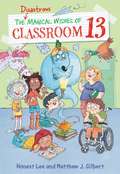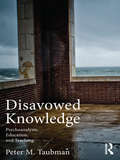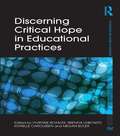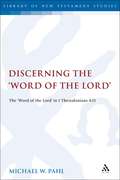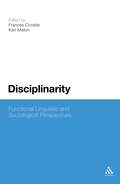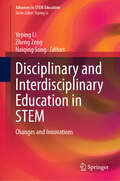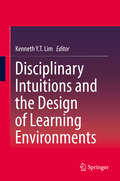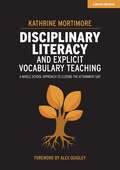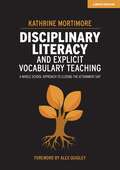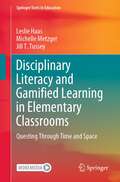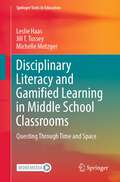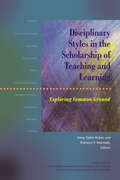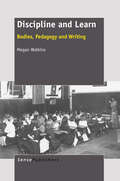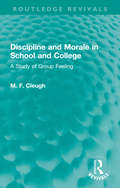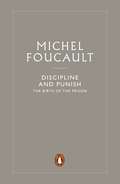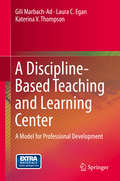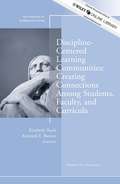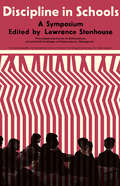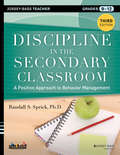- Table View
- List View
The Disastrous Magical Wishes of Classroom 13 (Classroom 13 #2)
by Honest Lee Matthew J. GilbertAs heard by kids everywhere on the Echo Dot Kids Edition, the Classroom 13 books are a hilarious new chapter book series-perfect for reluctant readers and fans of Roald Dahl, Captain Underpants, and Sideways Stories from Wayside School.The Disastrous Magical Wishes of Classroom 13 is the second title in a series about the students of a very unlucky classroom. The easy-to-read chapters are full of humor, action, secret codes, and fun-and will prompt hours of conversation among friends, families, and classmates. The final chapter encourages young readers to write their own chapter and send it in to the author, Honest Lee.When unlucky teacher Ms. Linda LaCrosse finds a magic lamp, she releases a genie-um, I mean, a Djinn--who agrees to grant each of her students ONE WISH!You might think this was fantastic, but it was not. It was a frightful idea! With magic wishes come hungry dinosaurs, stinky pizza, photographing paparazzi, and other huge mistakes. As the students of Classroom 13 are about to learn, you should be careful what you wish for.© 2017 by Hachette Book Group, Inc.
Disavowed Knowledge: Psychoanalysis, Education, and Teaching (Studies in Curriculum Theory Series)
by Peter Maas TaubmanThis is the first and only book to detail the history of the century-long relationship between education and psychoanalysis. Relying on primary and secondary sources, it provides not only a historical context but also a psychoanalytically informed analysis. In considering what it means to think about teaching from a psychoanalytic perspective and in reviewing the various approaches to and theories about teaching and curriculum that have been informed by psychoanalysis in the twentieth century, Taubman uses the concept of disavowal and focuses on the effects of disavowed knowledge within both psychoanalysis and education and on the relationship between them. Tracing three historical periods of the waxing and waning of the medical/therapeutic and emancipatory projects of psychoanalysis and education, the thrust of the book is for psychoanalysis and education to come together as an emancipatory project. Supplementing the recent work of educational scholars using psychoanalytic concepts to understand teaching, education, and schooling, it works to articulate the stranded histories ─ the history of what could have been and might still be in the relationship between psychoanalysis and education.
Disavowed Knowledge: Psychoanalysis, Education, and Teaching (Studies in Curriculum Theory Series)
by Peter Maas TaubmanThis is the first and only book to detail the history of the century-long relationship between education and psychoanalysis. Relying on primary and secondary sources, it provides not only a historical context but also a psychoanalytically informed analysis. In considering what it means to think about teaching from a psychoanalytic perspective and in reviewing the various approaches to and theories about teaching and curriculum that have been informed by psychoanalysis in the twentieth century, Taubman uses the concept of disavowal and focuses on the effects of disavowed knowledge within both psychoanalysis and education and on the relationship between them. Tracing three historical periods of the waxing and waning of the medical/therapeutic and emancipatory projects of psychoanalysis and education, the thrust of the book is for psychoanalysis and education to come together as an emancipatory project. Supplementing the recent work of educational scholars using psychoanalytic concepts to understand teaching, education, and schooling, it works to articulate the stranded histories ─ the history of what could have been and might still be in the relationship between psychoanalysis and education.
Discerning Critical Hope in Educational Practices (Foundations and Futures of Education)
by Vivienne Bozalek Brenda Leibowitz Ronelle Carolissen Megan BolerHow can discerning critical hope enable us to develop innovative forms of teaching, learning and social practices that begin to address issues of marginalization, privilege and access across different contexts? At this millennial point in history, questions of cynicism, despair and hope arise at every turn, especially within areas of research into social justice and the struggle for transformation in education. While a sense of fatalism and despair is easily recognizable, establishing compelling bases for hope is more difficult. This book addresses the absence of sustained analyses of hope that simultaneously recognize the hard edges of why we despair. The volume posits the notion of critical hope not only as conceptual and theoretical, but also as an action-oriented response to despair. Our notion of critical hope is used in two ways: it is used firstly as a unitary concept which cannot be disaggregated into either hopefulness or criticality, and secondly, as an analytical concept, where critical hope is engaged and diversely theorized in ways that recognize aspects of individual and collective directions of critical hope. The book is divided into four sub-sections: Critical Hope in Education Critical Hope and a Critique of Neoliberalism Critical Race Theory/Postcolonial Perspectives on Critical Hope Philosophical Overviews of Critical Hope. Education can be a purveyor of critical hope, but it also requires critical hope so that it, as a sector itself, can be transformative. With contributions from international experts in the field, the book will be of value to all academics and practitioners working in the field of education.
Discerning Critical Hope in Educational Practices (Foundations and Futures of Education)
by Vivienne Bozalek Brenda Leibowitz Ronelle Carolissen Megan BolerHow can discerning critical hope enable us to develop innovative forms of teaching, learning and social practices that begin to address issues of marginalization, privilege and access across different contexts? At this millennial point in history, questions of cynicism, despair and hope arise at every turn, especially within areas of research into social justice and the struggle for transformation in education. While a sense of fatalism and despair is easily recognizable, establishing compelling bases for hope is more difficult. This book addresses the absence of sustained analyses of hope that simultaneously recognize the hard edges of why we despair. The volume posits the notion of critical hope not only as conceptual and theoretical, but also as an action-oriented response to despair. Our notion of critical hope is used in two ways: it is used firstly as a unitary concept which cannot be disaggregated into either hopefulness or criticality, and secondly, as an analytical concept, where critical hope is engaged and diversely theorized in ways that recognize aspects of individual and collective directions of critical hope. The book is divided into four sub-sections: Critical Hope in Education Critical Hope and a Critique of Neoliberalism Critical Race Theory/Postcolonial Perspectives on Critical Hope Philosophical Overviews of Critical Hope. Education can be a purveyor of critical hope, but it also requires critical hope so that it, as a sector itself, can be transformative. With contributions from international experts in the field, the book will be of value to all academics and practitioners working in the field of education.
Discerning the "Word of the Lord": The Word of the Lord" in 1 Thessalonians 4:1 (The Library of New Testament Studies #389)
by Michael W. PahlIn 1 Thessalonians 4:15, the Apostle Paul appeals to a "word of the Lord" to provide authority for his eschatological encouragement. This appeal has left a perplexing problem related to the nature and function of the specific authority to which the phrase refers. Two theories have predominated in the history of interpretation: either 1) it refers to a directly received prophetic revelation, whether to Paul or to another Christian prophet; or 2) it refers to a teaching of Jesus received as tradition, whether preserved in the Gospel tradition or otherwise unknown.This book investigates this problem from three angles: epistemological analysis, examining Paul's authorities for his knowledge, particularly in his eschatology; linguistic analysis, including both grammatical and lexical study of the phrase; and contextual analysis, setting the statement within its historical and literary contexts. These approaches converge to suggest a fresh solution to the problem: while Paul does appear to employ traditional Christian eschatological teaching in his response to the Thessalonian crisis (4:16-17a), the phrase ?? ???? ?????? does not refer to this tradition, but rather refers to the proclaimed gospel message about Jesus centred on his death and resurrection which forms the theological foundation of Paul's response (cf. 4:14).
Disciplinarity: Functional Linguistics And Sociological Perspectives
by Frances Christie Karl MatonDisciplinary knowledge is under threat in the modern world. Claims abound that we are entering a landscape in which the division of disciplines is obsolete, implying a commitment to outdated values in scholarship. Notions of 'discipline' are critiqued as reflecting social power and representing the worldview of dominant social groups. By addressing and challenging such claims, this edited collection argues that proclamations of the death of disciplines have been greatly overstated. Not only are the notions of disciplinarity still important for understanding how we come to know the world, but this volume demonstrates how significant disciplinarity is to understanding different forms of knowledge if we wish to improve the building of knowledge and educational practice. Using analytical tools from systemic functional linguistics theory and social realist sociology, this volume illustrates how different disciplines can collaborate and cross-fertilize successfully, without losing their distinctive insights and disciplinary integrity. The subsequent theory developed will thereby extend both linguistic and sociological approaches to the topic and make a major contribution to educational theory.
Disciplinary and Interdisciplinary Education in STEM: Changes and Innovations (Advances in STEM Education)
by Yeping Li Zheng Zeng Naiqing SongThis book provides an international platform for educators from different STEM disciplines to present, discuss, connect, and develop collaborations in two inter-related ways: (1) sharing and discussing changes and innovations in individual discipline-based education in STEM/STEAM, and (2) sharing and discussing the development of interdisciplinary STEM/STEAM education. Possible relationships and connections between individual disciplines (like mathematics or physics) and STEM education remain under explored and the integration of traditionally individual discipline-based education in STEM education is far from balanced. Efforts to pursue possible connections among traditionally separated individual disciplines in STEM are not only necessary for the importance of deepening and expanding interdisciplinary research and education in STEM, but also for the ever-increasing need of reflecting on and changing how traditional school subjects (like mathematics or physics) can and should be viewed, taught, and learned. Scholars from eight countries/regions provide diverse perspectives and approaches on changes and innovations in STEM disciplinary and interdisciplinary education. Disciplinary and Interdisciplinary Education in STEM will be a great resource to students and researchers in STEM education as well as STEM curriculum developers and teacher educators internationally.
Disciplinary Intuitions and the Design of Learning Environments
by Kenneth Y. T. LimAs children, we would have spilt glasses of milk, dropped things, and broken things. As children, therefore, we would have developed intuitions about how the world ‘works’, but we would not necessarily have been able to explain these ‘workings’. It would only have been till we entered formal schooling that we would have learned codifications of canon within each respective discipline, and consequently how to articulate the canon to explain the intuition.The preceding example was from the natural sciences, but one could just have easily taken an example from, say, the environmental sciences or from the social sciences. Indeed, much of this book does just that, as it seeks to chart the territory of a new theory of learning around Disciplinary Intuitions.Many of the chapters within draw frequent and explicit linkages to curriculum design, from the premise of the need to go beyond addressing the conceptions of learners, to seeking to understand the substrate upon which these conceptions are founded. The argument is made that this substrate comprises the particular set of lived experiences of each learner, and how – because these lived experiences are as tacit as they are diverse – designing curriculum around misconceptions and preconceptions alone would not lead to enduring understanding from first principles. From this perspective, Disciplinary Intuitions constitute an exciting field at the nexus of learning theories and curriculum design.
Disciplinary Literacy and Explicit Vocabulary Teaching: A Whole School Approach To Closing The Attainment Gap
by Kathrine MortimoreFirmly rooted in research evidence of what works within the classroom for our most disadvantaged students, Disciplinary Literacy and Explicit Vocabulary Teaching offers teachers and school leaders practical ways in which those students who are behind in their literacy capabilities can make excellent progress. Building on the work of Geoff Barton in his influential book Don’t Call it Literacy, Kathrine Mortimore outlines the unique literacy challenges posed by specific subject areas for those with weaker literacy skills, and more importantly how these challenges can be addressed and overcome.A student’s GCSE results are vital in giving them the choices they deserve in order to go on to the next stage of their academic careers. This book draws on the success stories of schools and subjects that have made significant improvements in the outcomes of the children they teach, regardless of their starting points. From the inevitable success of Michaela Community school, to the gains made by the English department at Torquay Academy and the rapid reading improvements at Henley Bank, this book draws on both whole school initiatives and subject-specific strategies which have had proven success. This book places a wide and balanced knowledge-rich curriculum at the centre of any school improvement strategy designed to improve literacy, and illustrates the role that all subjects must combine to play in building the vital background knowledge and vocabulary that young people need in order to read independently. This curriculum must then be delivered using those teaching methods that have had the greatest impact on disadvantaged learners, and this book sets out how the methodology of direct and explicit instruction can be adopted within each subject area. Alongside this is a useful summary of staff development and inset which offers practical ways in which teachers’ adoption of these effective strategies can be facilitated.There are also useful sections on creating a whole school dictionary of essential vocabulary, creating a culture of reading and writing, and also those key literacy barriers experienced by those students with some of the most common special educational needs.
Disciplinary Literacy and Explicit Vocabulary Teaching: A whole school approach to closing the attainment gap
by Kathrine MortimoreFirmly rooted in research evidence of what works within the classroom for our most disadvantaged students, Disciplinary Literacy and Explicit Vocabulary Teaching offers teachers and school leaders practical ways in which those students who are behind in their literacy capabilities can make excellent progress. Building on the work of Geoff Barton in his influential book Don't Call it Literacy, Kathrine Mortimore outlines the unique literacy challenges posed by specific subject areas for those with weaker literacy skills, and more importantly how these challenges can be addressed and overcome.A student's GCSE results are vital in giving them the choices they deserve in order to go on to the next stage of their academic careers. This book draws on the success stories of schools and subjects that have made significant improvements in the outcomes of the children they teach, regardless of their starting points. From the inevitable success of Michaela Community school, to the gains made by the English department at Torquay Academy and the rapid reading improvements at Henley Bank, this book draws on both whole school initiatives and subject-specific strategies which have had proven success. This book places a wide and balanced knowledge-rich curriculum at the centre of any school improvement strategy designed to improve literacy, and illustrates the role that all subjects must combine to play in building the vital background knowledge and vocabulary that young people need in order to read independently. This curriculum must then be delivered using those teaching methods that have had the greatest impact on disadvantaged learners, and this book sets out how the methodology of direct and explicit instruction can be adopted within each subject area. Alongside this is a useful summary of staff development and inset which offers practical ways in which teachers' adoption of these effective strategies can be facilitated.There are also useful sections on creating a whole school dictionary of essential vocabulary, creating a culture of reading and writing, and also those key literacy barriers experienced by those students with some of the most common special educational needs.
Disciplinary Literacy and Gamified Learning in Elementary Classrooms: Questing Through Time and Space (Springer Texts in Education)
by Leslie Haas Michelle Metzger Jill T. TusseyThis textbook provides real world examples of how disciplinary literacy can incorporate gamified learning opportunities in elementary classrooms (grades K-5 or ages 5-11). It also presents concrete examples of how to seamlessly integrate literacy within other subjects in engaging and unique ways. Furthermore, this text offers practical information related to pedagogy, content, and differentiation for each lesson. Preservice teachers, practicing teachers, instructional coaches, and administrators can benefit from this user-friendly text and its companion digital components, allowing for replication of lessons based on national standards, backed by best-practices, and supported by differentiated pedagogy.This unique volume begins with engineering marvels that span across centuries and locations. The eight chapters focus on the following marvels in chronological order: Great Pyramid of Giza, Stonehenge, Leaning Tower of Pisa, Great Wall of China, Machu Picchu, Panama Canal, Golden Gate Bridge, and International Space Station. By focusing on these specific examples of human ingenuity, opportunities are created to delve into the historical and social aspects of each chapter’s focus. There are also occasions to explore the artistic merit and the art created about and around each focus. Additional teaching opportunities lie in understanding the science, engineering, technology, and math embedded in all featured marvels.Each chapter features an adventure roadmap in the form of a narrative quest set against the chapter’s marvel that guides teachers and student players through embedded activities. Activities are designed for lower elementary school (grades K-2 or ages 5-8) and upper elementary school (grades 3-5 or ages 8-11). Instructional support for both novice and career teachers is provided through differentiation strategies, resource materials, and teaching tips.
Disciplinary Literacy and Gamified Learning in Middle School Classrooms: Questing Through Time and Space (Springer Texts in Education)
by Leslie Haas Jill T. Tussey Michelle MetzgerThis textbook prepares teachers to incorporate gamified learning experiences into middle school classrooms. Its focus provides concrete examples of how to seamlessly integrate literacy across disciplines in a fun, engaging, and unique way for all learners. Furthermore, this book offers practical information related to pedagogy, content, and differentiation for each lesson. Preservice teachers, practicing teachers, instructional coaches, and administrators can benefit from this user-friendly text and its companion digital components, allowing for replication of lessons based on national standards, backed by best-practices, and supported by differentiated pedagogy.This unique book begins with engineering marvels that span across centuries and locations. The ten chapters, in chronological order, are titled: Acropolis, Petra, Colosseum, Chichen Itza, Moai, Red Square, Taj Mahal, Neuschwanstein, Eiffel Tower, and Sydney Opera House. By focusing on specific examples of human ingenuity, opportunities are created to delve into the historical and social aspects of each chapter’s focus. There are also chances to explore the artistic merit and the art created about and around each marvel. Additional teaching moments lie in understanding the science, engineering, technology, and math embedded in all featured marvels. Each chapter offers material lists, resource materials, and visual/graphic images to support understanding. Teaching tips and differentiation strategies are also provided to support novice and career teachers alike.
Disciplinary Styles in the Scholarship of Teaching and Learning: Exploring Common Ground
by Mary Taylor Huber Sherwyn P. MorrealeTen sets of disciplinary scholars respond to an orienting essay that raises questions about the history of discourse about teaching and learning in the disciplines, the ways in which disciplinary "styles" influence inquiry into teaching and learning, and the nature and roles of interdisciplinary exchange. The authors hope to "contribute to a common language for trading ideas, enlarging our pedagogical imaginations, and strengthening our scholarly work." Disciplines represented: chemistry; communication studies, engineering, English studies, history, management sciences, mathematics, psychology, and sociology. A collaboration of The Carnegie Foundation for the Advancement of Teaching and AAHE
Disciplinary Styles in the Scholarship of Teaching and Learning: Exploring Common Ground
Ten sets of disciplinary scholars respond to an orienting essay that raises questions about the history of discourse about teaching and learning in the disciplines, the ways in which disciplinary "styles" influence inquiry into teaching and learning, and the nature and roles of interdisciplinary exchange. The authors hope to "contribute to a common language for trading ideas, enlarging our pedagogical imaginations, and strengthening our scholarly work." Disciplines represented: chemistry; communication studies, engineering, English studies, history, management sciences, mathematics, psychology, and sociology. A collaboration of The Carnegie Foundation for the Advancement of Teaching and AAHE
Discipline and Learn: Bodies, Pedagogy And Writing
by Megan WatkinsDiscipline and Learn: Bodies, Pedagogy and Writing explores how discipline is typically construed as a form of subjection in contemporary educational thought and in critical and cultural theory more broadly. It provides a critique of this emphasis on the repressive aspects of discipline highlighting its enabling potential and role in the development of dispositions to learning. The book engages with the work of a range of theorists: Foucault, Bourdieu, Merleau-Ponty, Mauss and Spinoza and considers their usefulness in theorizing embodiment and learning in the teaching of writing in the early years of school. Emphasis, however, is placed on the work of Bourdieu and his notion of habitus melding theory and practice in an ethnography of contemporary classrooms. This text is invaluable reading for students and academics across the social sciences and humanities interested in questions of embodiment, affect and their relation to learning. This is the most thought-provoking book to be published on pedagogy in a long, long time. Conceptually elegant and empirically rich, it undercuts conventional wisdom and potentially rearranges how we think about teaching, learning and writing. It argues that students’ bodies not just their minds matter in learning, explaining how, in practice, the desire to learn is a mindful bodily disposition. And it shows how, through an enabling form of discipline, teachers can produce a scholarly habitus in all students, including the educationally disadvantaged and defiant. Jane Kenway, Professor of Education, Monash University Discipline and Learn: Bodies, Pedagogy and Writing an excellent book which makes an important contribution to our understanding of both pedagogy and the body and which is sure to spark debate in both fields. It is careful and judicious in its approach but still manages to be provocative and original. Nick Crossley, Professor of Sociology, University of Manchester
Discipline and Morale in School and College: A Study of Group Feeling (Routledge Revivals)
by M. F. CleughOriginally published in 1971, the author was concerned with a nexus of related ideas: group spirit, morale, discipline, discrimination, stigma. How, she asks, are these connected with leadership, both that of the assigned person in authority, lecturer or teacher, and that of the dominant spirits within the group? What is their relation to backwardness, and the place of the slow learner in the school morale system? Answering these and other questions, particularly around morale, the first part of the book contains a number of case studies and examples of varying degrees of complexity. These are intended to act as pointers or guides for the discussion of problems, which takes up the second half of the book.
Discipline and Morale in School and College: A Study of Group Feeling (Routledge Revivals)
by M. F. CleughOriginally published in 1971, the author was concerned with a nexus of related ideas: group spirit, morale, discipline, discrimination, stigma. How, she asks, are these connected with leadership, both that of the assigned person in authority, lecturer or teacher, and that of the dominant spirits within the group? What is their relation to backwardness, and the place of the slow learner in the school morale system? Answering these and other questions, particularly around morale, the first part of the book contains a number of case studies and examples of varying degrees of complexity. These are intended to act as pointers or guides for the discussion of problems, which takes up the second half of the book.
A Discipline-Based Teaching and Learning Center: A Model for Professional Development
by Gili Marbach-Ad Laura C. Egan Katerina V. ThompsonThis book describes the design and implementation of a discipline-specific model of professional development: the disciplinary Teaching and Learning Center (TLC). TLC was born from a strong commitment to improving undergraduate science education through supporting the front-line educators who play an essential role in this mission. The TLC’s comprehensive approach encompasses consultation, seminars and workshops, acculturation activities for new faculty members, and teaching preparatory courses as well as a certificate program for graduate students. At the University of Maryland, TLC serves biology and chemistry faculty members, postdoctoral associates, and graduate students. The Center is deeply integrated into the departmental culture, and its emphasis on pedagogical content knowledge makes its activities highly relevant to the community that it serves. The book reflects ten years of intensive work on the design and implementation of the model. Beginning with a needs assessment and continuing with ongoing evaluation, the book presents a wealth of information about how to design and implement effective professional development. In addition, it discusses the theory underlying each of the program components and provides an implementation guide for adopting or adapting the TLC model and its constituent activities at other institutions. In this book, the authors describe how they created the highly successful discipline-based Teaching and Learning Center at the University of Maryland. This is a must read for anyone interested in improving higher education.Charles Henderson, Co-Director, Center for Research on Instructional Change in Postsecondary Education, Western Michigan University This book will provide a much-needed resource for helping campus leaders and faculty development professionals create robust programs that meet the needs of science faculty. Susan Elrod, Dean, College of Science and Mathematics, Fresno StateThe authors provide a road map and guidance for higher education professional development in the natural science for educators at all levels. While the examples are from the sciences, the approaches are readily adaptable to all disciplines.Spencer A. Benson, Director of the Centre for Teaching and Learning Enhancement, University of Macau
Discipline-Centered Learning Communities: New Directions for Teaching and Learning, Number 132 (J-B TL Single Issue Teaching and Learning #152)
by Kimberly Buch Kenneth E. BarronTake an in depth look at discipline-centered learning communities. Using psychology as an example, this issue provides prescriptive advice for those interested in developing a learning community in any academic discipline or program. Learning communities are a powerful vehicle for creating and sustaining connections among students, faculty, and the curriculum, but creating one can be a challenge. By providing resources, practical case studies, and theoretical grounding, this volume can both inspire and guide faculty, staff, and administrators in meeting their pedagogical and curricular goals. Learn how the five types of learning communities—based curricularly, residentially, in the classroom, on the students themselves, and even virtually—can be used to enhance student engagement and learning. Illustrating the versatility of the practice across a wide range of settings, student populations, and institutional types, this issue also contains an extensive listing of resources that go beyond disciplinary boundaries and open possibilities for all in higher education. This is the 132nd volume of this Jossey-Bass higher education series. New Directions for Teaching and Learning offers a comprehensive range of ideas and techniques for improving college teaching based on the experience of seasoned instructors and the latest findings of educational and psychological researchers.
Discipline-Centered Learning Communities: New Directions for Teaching and Learning, Number 132 (J-B TL Single Issue Teaching and Learning #154)
by Tl Kimberly Buch Kenneth E. BarronTake an in depth look at discipline-centered learning communities. Using psychology as an example, this issue provides prescriptive advice for those interested in developing a learning community in any academic discipline or program. Learning communities are a powerful vehicle for creating and sustaining connections among students, faculty, and the curriculum, but creating one can be a challenge. By providing resources, practical case studies, and theoretical grounding, this volume can both inspire and guide faculty, staff, and administrators in meeting their pedagogical and curricular goals. Learn how the five types of learning communities—based curricularly, residentially, in the classroom, on the students themselves, and even virtually—can be used to enhance student engagement and learning. Illustrating the versatility of the practice across a wide range of settings, student populations, and institutional types, this issue also contains an extensive listing of resources that go beyond disciplinary boundaries and open possibilities for all in higher education. This is the 132nd volume of this Jossey-Bass higher education series. New Directions for Teaching and Learning offers a comprehensive range of ideas and techniques for improving college teaching based on the experience of seasoned instructors and the latest findings of educational and psychological researchers.
The Discipline Coach: If you're thinking discipline is keeping them in check, sorting them out, showing them what's good for them, because it's for their own good, because it's what the youth of today are sorely lacking ... you've got the wrong book
by Jim RobersonJim Roberson believes that school should be the place where you learn all you need to learn to succeed in life, whatever form that success may take. Most importantly, in his view, you have to learn discipline. For Jim, behaviour is the 'B-word' and he forbids mention of it. Discipline, on the other hand, is neatly described not as something others do to you to get you to behave nor even as something you do to yourself, but rather as 'what you do for yourself'. What Jim advocates is a partnership between children and schools, whereby schools open up to teaching children everything they will need to prosper at and beyond school, no matter what career or life choices they make. In return, children will start to acquire and then implement the strategies and benefits that come with self-discipline on an ongoing basis. Jim has worked with some of the most challenging young people in the UK and, whether he's working with experienced classroom practitioners, struggling supply teachers, students themselves or even the police, he delivers powerful, practical, common sense strategies that bring the best out of some of the most demanding and hard-to-reach young people.
Discipline in Schools: A Symposium
by Lawrence StenhouseDiscipline in Schools: A Symposium is a collection of papers that tackles the issues, concerns, and problems in disciplining students. The book aims to supplement group tutorial course about classroom discipline. The title first details the concept of discipline in an educational setting, and then proceeds to discussing the dynamics and mechanisms of discipline in the classroom. Next, the selection covers the sociological factors in the environment of the pupils outside the school. Chapter 4 tackles the problems in discipline from developmental psychology perspective. The text also tackles the relationship between punishment and discipline. The book will be of great use to educators and behavioral scientists. Parents and legal guardians will also benefit from the text.
Discipline in the Secondary Classroom: A Positive Approach to Behavior Management
by Randall S. SprickRevised edition of the classic book on classroom management This third edition of Discipline in the Secondary Classroom is a treasure trove of practical advice, tips, checklists, reproducibles, and ready-to-use activities that will save secondary teachers time and help them become more effective educators. Both new and seasoned teachers will find the book invaluable for designing a management plan that prevents problems, motivates students, and teaches students to behave responsibly. Offers a proven classroom management plan based on Sprick's acclaimed STOIC framework for training teachers: Structure for success, Teach expectations, Observe and monitor, Interact positively, and Correct fluently Includes information on everything from creating a vision for classroom behavior to addressing misbehavior and motivating students Bonus DVD features video of Sprick explaining core practices This accessible, value-packed resource shows educators how to work with students to create a well-managed classroom where learning can flourish.
